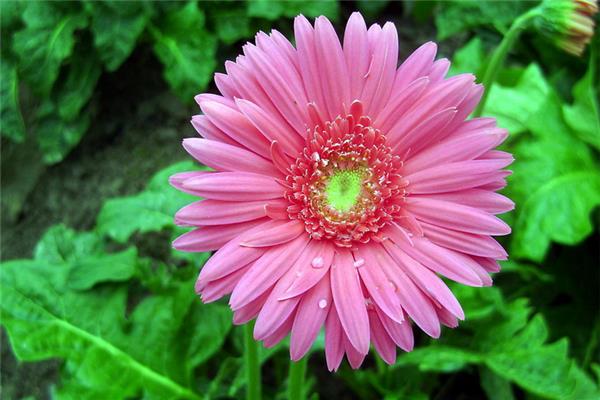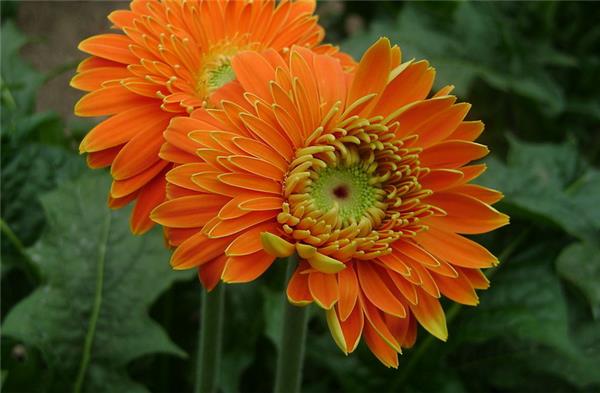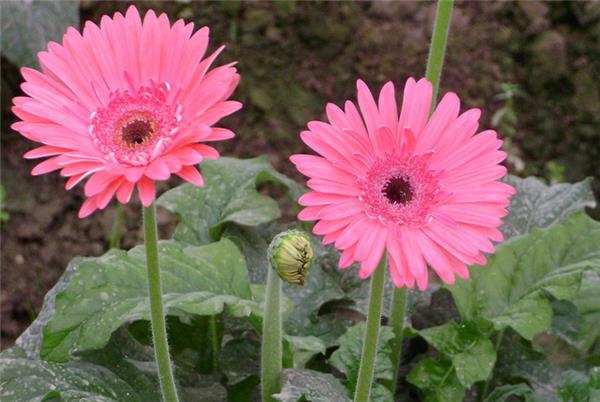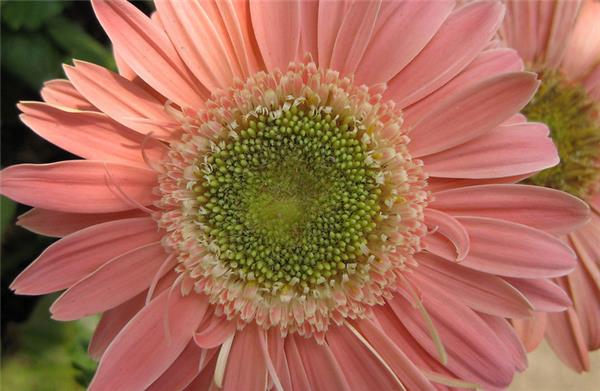How to breed beautiful Gerbera
African chrysanthemum is a beautiful ornamental flower with large flowers, rich colors and labor-saving management. it can supply fresh cut flowers all the year round in warm areas. Let's take a look at the knowledge of African chrysanthemum.

Introduction of African chrysanthemum
African chrysanthemum is a perennial herb of Compositae, the whole plant has fine hairs, terminal inflorescences, most of the leaves are basal, pinnately lobed. Plant height 30-45cm, head solitary, terminal inflorescence, flower colors are red, white, yellow, orange, purple and so on. 20-40cm above the leaf surface, 10-12cm in diameter, involucral bracts discoid, campanulate, ligulate petals in double shape, usually flowering in four seasons, with spring and autumn at their peak. It is an important material in modern cut flowers. The diameter of African chrysanthemum is larger (8-10 cm), and the florescence is easy to regulate. now the cultivation area of cut flowers is increasing year by year, and it is used more and more widely. African chrysanthemum can also withstand long-distance transportation and provide cut flowers for a long time; if the cultivation method is proper, 30 cut flowers can be cut from each plant in a year, which can be divided into modern cut flower type and dwarf cultivation type, with white, pink, red, yellow and other flower colors.

2. Cultivation techniques of African chrysanthemum
During the growing period, the optimum temperature was 20-25 ℃. When the temperature was lower than 10 ℃ or higher than 30 ℃, the gerbera stopped growing and was in a semi-dormant state. If you want to bloom all the year round, you need to maintain more than 12-15 ℃ in winter and no more than 26 ℃ in summer, so you can spend the winter in the open field in southern Fujian, but in order to get cut flowers with high yield and good quality, it is best to have heat preservation equipment such as plastic greenhouses, which can be replaced with sunshade nets or water spray to cool down in summer to ensure the supply of cut flowers all the year round.
(1) the soil should be disinfected. African chrysanthemum is not strict on soil, so it is suitable to use sandy soil which is loose and breathable and rich in humus. Because the pathogens of many diseases of African chrysanthemum can survive in the soil, and there are underground pests and earthworms in the soil, soil disinfection should be carried out before planting.
(2) soil preparation and fertilization. Because African chrysanthemum is afraid of stagnant water, it is generally cultivated in high border, the border is generally north-south, the border height is about 30cm, the border width is 1m and the border width is 40-50cm. Combined with soil preparation, base fertilizer should be applied, and circle fertilizer 200kg should be applied every 100m.
(3) colonization. The planting time should be cloudy or sunny in the evening. Except the high temperature period from July to September in summer is not suitable for planting, the rest of the time can be carried out. Planting must be shallow, so that the root neck exposed to the soil surface is appropriate, and irrigated just planted plants with sunshade net.
(4) pay attention to the management of seedling stage. Heat preservation or cooling management was carried out according to the weather conditions during the planting period, and the growth was quickly restored by controlling 20-25 ℃. After slowing down the seedlings, 1:10 human feces and urine can be applied every two weeks to ensure that each plant has 8-10 healthy leaves into flowering. When watering and fertilizing, be careful not to put water on the center of the leaves, otherwise it is easy to make the flower buds rot.

(5) Fertilizer and water management. African chrysanthemum can resist drought but not temperature, avoid waterlogging, the seedling stage should be properly moist to promote root development, the amount of water in the growing period can be determined according to the dry and wet condition of the soil, do not dry do not water, watering will be thoroughly. Watering as little as possible in winter, the soil is a little better. In summer, the hot water evaporates quickly, the plant enters the semi-dormant state, the flower yield decreases obviously, and the plant growth is weak. at this time, diseases and insect pests can be easily occurred combined with topdressing to promote the absorption of fertilizer by the root system. In summer, it is necessary to loosen the soil in time, clear roots and prevent diseases, control water and fertilizer, shade and prevent rain.
(6) peeling leaves and thinning buds. African chrysanthemum can blossom annually in the range of 5-30 ℃, so there is a large amount of fertilizer in the whole growing period. Before flower bud differentiation, organic fertilizer and nitrogen fertilizer should be applied to promote the full growth of plants, often dominated by potassium dihydrogen phosphate and urea, plus appropriate amount of liquid organic fertilizer, once a week, the plant should enter a period of both nutrition and reproductive growth. the proportion of phosphorus and potassium fertilizer should be increased, generally once a week. At the same time, appropriate amount of organic fertilizer should be sprayed on the leaves to meet the needs of reproductive growth before the peak flowering periods of April-June and September and November.
(7) humidity and light. African chrysanthemum is more hardy, its growth is not sensitive to light, but it likes to have plenty of sunshine. Cultivated in the greenhouse, adding 2-3 layers of plastic film in winter can safely survive the winter. Cover a layer of plastic film before the first frost comes in late October, and a small shed should be built on each bed around November to keep warm. 50% shading net can be used to cool down from June to September.

(8) remove the remnant leaves. The tufted leaves at the base of African chrysanthemum are easy to wither, yellow and senile, and should be removed in time, which is not only conducive to the germination of new leaves and flower buds, but also conducive to ventilation and light, so as not to cause the lower young buds to form "hidden buds" without sunlight and hormones. In addition, for too many buds or deformed flowers should also be removed in time to ensure that the remaining branches have enough nutrition to improve the quality of cut flowers. Generally, an annual single plant has 15-20 healthy leaves in full bloom and can produce 5-6 flowers per month.
(9) harvesting and preservation. When the outermost two layers of ligulate flowers of African chrysanthemum head are perpendicular to the flower stem and show the unique color of this variety, the best time is when the temperature is low in the morning and evening, and the plant is easy to be picked without hurting the plant. the method is to hold the lower part of the flower stem by hand and shake it to the left and right. Pick out the flowers with disease spots, insect spots and deformities, wrap them with 12-15 funnel-shaped plastic bags, then grade them according to variety and length, tie them with rubber bands and sell them. If it is not sold immediately, it should be kept upright in a bucket or other container with clear water, and the water depth should be 5-10cm at the base of the submerged flower stem.
The above is the knowledge of Gerbera. I hope I can help you.
It is also conducive to ventilation and light, so as not to cause the lower young buds to get no sunlight and hormones to form "hidden buds". In addition, for too many buds or deformed flowers should also be removed in time to ensure that the remaining branches have enough nutrition to improve the quality of cut flowers. Generally, an annual single plant has 15-20 healthy leaves in full bloom and can produce 5-6 flowers per month.
(9) harvesting and preservation. When the outermost two layers of ligulate flowers of African chrysanthemum head are perpendicular to the flower stem and show the unique color of this variety, the best time is when the temperature is low in the morning and evening, and the plant is easy to be picked without hurting the plant. the method is to hold the lower part of the flower stem by hand and shake it to the left and right. Pick out the flowers with disease spots, insect spots and deformities, wrap them with 12-15 funnel-shaped plastic bags, then grade them according to variety and length, tie them with rubber bands and sell them. If it is not sold immediately, it should be kept upright in a bucket or other container with clear water, and the water depth should be 5-10cm at the base of the submerged flower stem.
The above is the knowledge of Gerbera. I hope I can help you.
- Prev

Introduction and culture methods of onion orchids how to raise graceful green onion orchids
Introduction and culture methods of onion orchids how to raise graceful green onion orchids
- Next

Introduction and culture methods of torch flower how to grow torch flower like torch flower
Introduction and culture methods of torch flower how to grow torch flower like torch flower
Related
- Wuhan Hospital Iron Tree Blooming Result Was Instantly Frightened by the Gardener Master
- Which variety of camellia is the most fragrant and best? Which one do you like best?
- What is the small blue coat, the breeding methods and matters needing attention of the succulent plant
- Dormancy time and maintenance management of succulent plants during dormancy
- Minas succulent how to raise, Minas succulent plant pictures
- What are the varieties of winter succulent plants
- How to raise succulent plants in twelve rolls? let's take a look at some experience of breeding twelve rolls.
- Attention should be paid to water control for succulent plants during dormant period (winter and summer)
- Watering experience of twelve rolls of succulent plants
- Techniques for fertilizing succulent plants. An article will let you know how to fertilize succulent plants.

